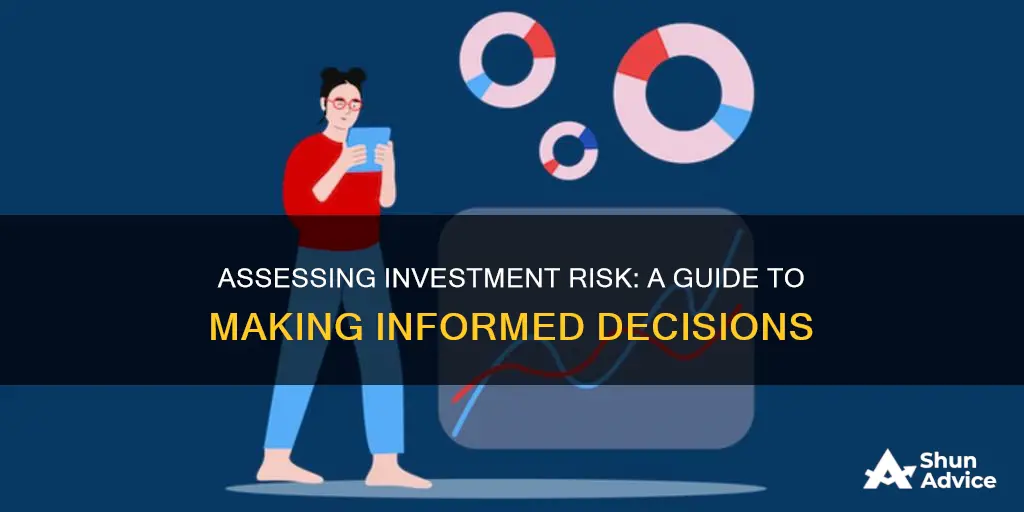
Investment risk refers to the possibility of losing money, with the main risk being that you might not get back what you put in. It is important to understand the risks and rewards involved in any investment, as all investments involve some degree of risk. The relationship between risk and return is a general trade-off that underlies nearly anything from which a return can be generated. The higher the risk, the higher the possible return.
There are several types of investment risks, including market risk, credit risk, reinvestment risk, inflation risk, and liquidity risk. It is important to assess your risk tolerance and risk capacity before making any investment decisions. Risk tolerance refers to how much risk you can emotionally stand, while risk capacity is the amount of financial risk you can take on.
To determine your risk tolerance and capacity, consider factors such as your knowledge of different types of investments, your savings for emergencies, your investment time horizon, and your concerns about inflation. By understanding your risk profile and conducting a risk assessment, you can make more informed investment decisions that align with your financial goals.
| Characteristics | Values |
|---|---|
| Risk-reward trade-off | The higher the risk, the higher the possible return |
| Risk tolerance | How much risk an individual is willing to accept |
| Risk capacity | How much risk an individual can afford to take |
| Time horizon | The amount of time an individual has to keep their money invested |
| Bankroll | The amount of money an individual can afford to lose |
| Inflation risk | The risk of inflation eroding the purchasing power of savings |
| Market risk | The risk of losing investments due to factors affecting the performance of the overall market |
| Interest rate risk | The risk of interest rates fluctuating due to factors like inflation |
| Currency risk | The risk of losing money due to changing exchange rates |
| Liquidity risk | The risk of not being able to redeem an investment for cash |
| Concentration risk | The risk of losing money by investing in only one security or asset class |
| Credit risk | The risk of the bond issuer defaulting on payments |
| Reinvestment risk | The risk of reinvesting at a lower rate of return than the original investment |
| Foreign investment risk | The risk of losing money due to fluctuating exchange rates, civil or political unrest, falling GDP, or rising inflation in foreign markets |
What You'll Learn

Understanding risk tolerance and risk capacity
When deciding on an investment strategy, it's important to consider your risk tolerance and risk capacity. Risk tolerance refers to an individual's willingness to take on risk, while risk capacity is the amount of financial risk one can take given their current financial situation. While risk tolerance is subjective and influenced by factors like personality, age, income, and net worth, risk capacity is more mathematical and fact-based, focusing on what level of risk is appropriate given one's situation and goals.
Risk Tolerance
Risk tolerance is a personal decision and can vary from person to person. Some individuals may be risk-averse, avoiding risk at all costs, while others may be risk-seekers who enjoy the thrill of taking risks. It's important to assess your risk tolerance honestly and understand how comfortable you are with taking on risk. Factors such as age, income, family situation, and net worth can influence your risk tolerance. For example, if rapid changes in your investment's value would cause you anxiety, you may have a lower risk tolerance.
Risk Capacity
Risk capacity, on the other hand, tells you how much money you can afford to put at risk. It considers factors such as your current financial situation, investment goals, and time horizon. For instance, if you are investing for retirement, you need to assess how much money you can invest, your current retirement savings, how long you have until retirement, and the rate of return needed to achieve your desired lifestyle. If your investments only need to earn a low rate of return to meet your goals, your risk capacity is likely low. On the other hand, if you require a higher rate of return, you may have a higher risk capacity and may need to invest in riskier options.
Balancing Risk Tolerance and Risk Capacity
It's important to note that your risk tolerance and risk capacity may not always align. As your circumstances change over time, your risk tolerance and capacity may fluctuate. Life events, such as inheriting a large sum of money, can impact both your risk tolerance and capacity. It's crucial to periodically reassess your risk profile and adjust your investment strategy accordingly. While risk tolerance tends to decrease with age, life events can either increase or decrease it. Therefore, consulting a financial professional can help you determine your risk profile and make informed investment decisions.
Understanding Reasonable Invested Equity: Your Smart Money Move
You may want to see also

Evaluate your comfort zone for taking on risk
Evaluating your comfort zone for taking on risk is a crucial step in the investment decision-making process. All investments carry some level of risk, and understanding your risk tolerance is essential. Risk tolerance refers to how much risk you are emotionally and financially able to handle.
To assess your comfort zone for taking on risk, consider the following:
- Time Horizon: Determine how long you plan to invest your money. If you have a short-time horizon and may need access to your funds soon, investing in high-risk, volatile assets may not be wise, as you may be forced to sell at a loss. A longer time horizon provides more opportunity to recoup potential losses, allowing for a higher risk tolerance.
- Bankroll: Assess how much money you can afford to lose. This approach may seem pessimistic, but it is realistic. Investing only what you can afford to lose without experiencing financial pressure ensures you won't be forced to sell due to panic or liquidity issues. Those with higher net worth can typically tolerate more risk.
- Knowledge: A good understanding of different investments and terms can increase your comfort with risk. Consult a financial advisor if you feel your knowledge is limited.
- Emergency Savings: Ensure you have adequate savings to cover emergencies and unexpected expenses. A general guideline is to aim for three months' worth of living expenses, but this may vary depending on your job security, skill demand, and fixed expenses.
- Investment Goals: Consider your financial goals and how risk impacts them. For example, if you are saving for retirement or other long-term goals, you may need to include riskier investments like stocks to meet your goals. On the other hand, if you are saving for a short-term goal, lower-risk investments like cash equivalents may be more appropriate.
- Risk of Distress: Ask yourself how you would feel if the market experienced a significant downturn and your investments lost value. If you think you would panic and liquidate your investments, your risk tolerance is likely low. If you would remain patient and wait for a potential recovery, your tolerance is higher.
By considering these factors, you can evaluate your comfort zone for taking on risk and make more informed investment decisions.
Volcker Rule: Impact on Investment Management Firms?
You may want to see also

Risk and return
Types of Risk
There are several types of investment risks, which can be broadly categorised into systematic and unsystematic risks. Systematic risks, also known as market risks, affect the entire market or a large portion of it and include factors such as political and macroeconomic instability. Unsystematic risks, on the other hand, are specific to a particular industry or company, such as changes in management or a new competitor entering the market.
Determining Risk Tolerance
When deciding on an investment strategy, it is crucial to consider your risk tolerance, which refers to how much risk you are emotionally and financially comfortable accepting. Factors such as time horizon, bankroll, investment goals, and risk appetite will influence your risk tolerance.
Managing Risk
While it is impossible to eliminate investment risk, it can be managed through various strategies such as diversification, long-term investment horizons, and dollar cost averaging. Diversification, for example, involves spreading your investments across different asset classes, industries, and sectors to reduce the overall risk of your portfolio.
The risk-return trade-off refers to the balance between seeking the lowest possible risk and aiming for the highest potential returns. Generally, low-risk investments are associated with lower returns, while high-risk investments offer the potential for higher returns. However, it is important to note that higher risk does not guarantee higher returns, and investors must carefully assess their risk tolerance and financial goals before making investment decisions.
Inventories Management and Inter-corporate Investments: Strategies for Success
You may want to see also

Risk management strategies
Risk management is an important aspect of investing, as it helps to mitigate potential losses and protect your investments. Here are some strategies to consider:
- Diversification: This is a fundamental risk management strategy that involves spreading your investments across various asset classes, industries, and sectors. By diversifying your portfolio, you reduce the impact of losses in one area by gains in another. It is a way to balance your risk and return expectations.
- Long-term Investment Horizons: Investing for the long term can help smoothen out short-term market volatility and give your investments a better chance to recover from any losses. This strategy is particularly suitable for investors with a higher risk tolerance and a longer time horizon.
- Dollar Cost Averaging: This strategy involves investing a fixed amount of money consistently over regular intervals, regardless of the market conditions. By doing so, you buy more of an investment when its price is low and less when its price is high, which can help to reduce the impact of market fluctuations on your portfolio.
- Risk Assessment and Monitoring: Regularly assessing and monitoring your risk exposure is crucial. This includes understanding the different types of risks, such as market risk, credit risk, liquidity risk, and inflation risk, and evaluating how they apply to your specific investments. It also involves periodically reviewing your investment portfolio to ensure it aligns with your risk tolerance and financial goals.
- Professional Advice: Consulting a financial advisor or a wealth manager can be beneficial, especially if you are new to investing or need help determining your risk tolerance and creating a risk management plan. They can provide guidance tailored to your specific circumstances and goals.
- Risk Management Models: There are several academic models and metrics that can be used to measure, analyse, and manage investment risks, such as standard deviation, beta, Value at Risk (VaR), and the Capital Asset Pricing Model (CAPM). These tools can help you quantify and assess the risks associated with different investments and make more informed decisions.
Passive Investing: Risks and Rewards Explored
You may want to see also

Risk and time horizons
Time horizon is a key factor in determining an investor's risk tolerance and capacity. The time horizon refers to the length of the investment holding period or the time an investor has to reach their financial goals.
A longer time horizon generally allows for a greater risk appetite as there is more time to recover from market downturns and volatility. Younger investors with a longer time horizon until retirement, for example, may be more willing to invest in higher-risk investments with higher potential returns. Conversely, older investors with shorter time horizons may have a lower risk tolerance as they will need funds to be more readily available.
The time horizon is also important when considering the impact of inflation. Low-risk investments may not yield large enough returns to keep up with inflation over time. Therefore, investors concerned about the eroding purchasing power of their savings may be motivated to accept more investment risk.
Additionally, the time horizon can influence an investor's liquidity needs. If an investor needs immediate access to their funds, they are less likely to invest in high-risk or illiquid investments.
When determining their time horizon, investors should consider their financial goals, investment purposes, and emergency funds. For instance, if an investor is saving for a long-term goal, such as retirement, including riskier assets like stocks or mutual funds may be appropriate. On the other hand, investing solely in cash or cash equivalents may be more suitable for short-term financial goals.
It is also important to note that the time horizon can change due to life events or changes in circumstances. Therefore, investors should regularly reassess their investment risk tolerance and capacity to ensure it aligns with their time horizon and financial goals.
Green Finance: Haven's Investment Management Strategy
You may want to see also
Frequently asked questions
Investment risk refers to the possibility of losing some or all of the money invested due to adverse market movements or other unforeseen circumstances. It is important to understand the nature and extent of investment risk to make well-informed financial decisions.
Risk tolerance refers to how much risk an individual can emotionally stand. If you have a low-risk tolerance, you may panic and liquidate your investments during a market correction. On the other hand, if you have a high-risk tolerance, you are more likely to be patient and wait for the market to recover. It is crucial to assess your risk tolerance before investing.
The longer your investment horizon, the greater the risk you can afford to take. With a longer time horizon, you have more time to recover from any potential losses. Therefore, a longer investment horizon generally translates to a higher risk tolerance.
While it is impossible to eliminate investment risk entirely, it can be managed through diversification. Diversification involves spreading your investments across various asset classes, industries, and sectors to reduce the overall risk of your portfolio. Mutual funds are a popular way to achieve diversification.







